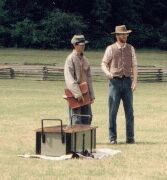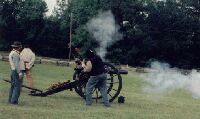|
The Parrott rifle was not something you would fire from your shoulder. While it is
a muzzleloader, it was a crew served weapon that saw combat during the Civil War.
Some historians credit it as the first modern artillery piece. With a rifled bore and
accurate ammunition, it was one of the favorite pieces of both the Union and
Confederate armies during our Civil War. It fired both fused and point impacting
explosive rounds, along with shot (solid ball) and grape (large charge of small balls).
The piece was extremely versatile and took artillery another step closer to the large
guns used in our modern wars.
I was privileged recently to be invited to a demonstration of the Parrott rifle being
fired, at the Mansfield Battle Park near the town of Mansfield, Louisiana. A small crowd showed up to watch the demonstration. Park staff fired the piece and answered questions regarding the
mechanics of the gun.
 The crew consists of 6 people, numbered One through Six. In this picture, you
can see Numbers 1, 2, 3, and 4. Starting at the far right is
Number 1. You can see the ramrod in her hand. (Yes Maude, women served, although
concealing their gender.) It is her job to place the charge in the barrel and to
insure that after firing, the remnants of the powder bag are extracted from the gun. The crew consists of 6 people, numbered One through Six. In this picture, you
can see Numbers 1, 2, 3, and 4. Starting at the far right is
Number 1. You can see the ramrod in her hand. (Yes Maude, women served, although
concealing their gender.) It is her job to place the charge in the barrel and to
insure that after firing, the remnants of the powder bag are extracted from the gun.
Next is Number 2. He has a large wet swab. It is his job to make sure the barrel
is swabbed after firing, to extinguish any live embers. He also seats the new charge
after it has been placed in the barrel by Number 1.
Next in line, from right to left, is number 4. He is the fellow dressed in the grey
hat. His job is to make sure the vent is open, that the powder bag is punctured and that
the primer is properly placed. I'm sure we have all seen the movies that show the actors
firing a cannon by using a torch.
According to the staff at the park, that wasn't the way the guns were fired.
Cannon crews got extemely excited when open flames were brought around their guns,
because of the large amounts of powder needed to fire them. The primers used during
the Civil War were friction primers. About a quarter of an inch in diameter, four inches
long and made of brass, the primer had a friction device that was pulled from it, igniting
a charge in the primer that fired into the main powder bag, much like the percussion
caps we used today.
The number 3 man, on the far left in this picture, was the guy who fired the
cannon. He attached a lanyard to the friction primer, insured that the rest of the crew
was safely positioned, and fired the gun on order. Because Number 3 jerked the
lanyard, he was also affectionately known as The Jerk.
 | | The box contained projectiles and powder charges. Sometimes on wheels, it was called a caisson. |
The two other members of the crew, Number 5 and 6, stayed back by the
charges. Number 5 was the sergeant in charge of the gun. He is the guy on the right in
this picture. It was his job to make sure that the proper
charges were loaded, that the crew was well drilled, that the cannon was aimed
properly, and that the crew and cannon were able to complete the missions that were
assigned.
Last, but not least, was Number 6, often the youngest member of the crew. He
carried the charges to the cannon, assisted other members in moving the piece, and
was a general Go-for for the crew. He was also called the Powder Monkey.
When the drill went well and the crew worked as a team, they were able to fire
the Parrott rifle up to three times in a minute, putting forth an incredible amount of fire.
 | | Notice #1 and #2 covering their ears and watching the muzzle. Part of their duty was to visually verify that the cannon fired. |
Some modern artillery crews are hard-pressed to maintain that
volume of fire. When a number of these guns are fired together, during re-enactments,
the ground shakes. A friend who lives in Mansfield, three miles away, tells me that he
can routinely hear the guns from his house.
To see this gun up close, visit the Mansfield Battle Park, just south of Mansfield,
Louisiana. There are signs directing you to the park off US Highway 84.
|